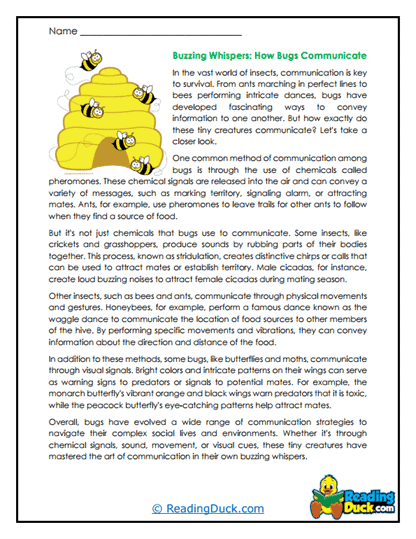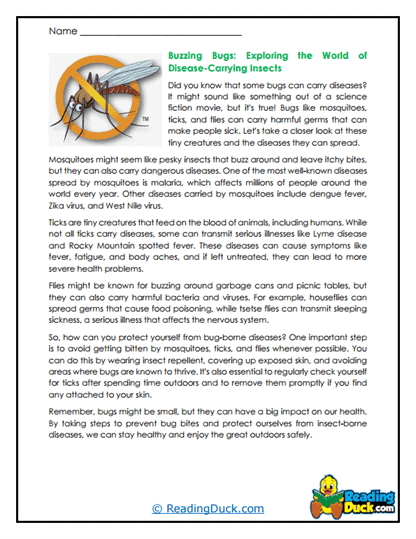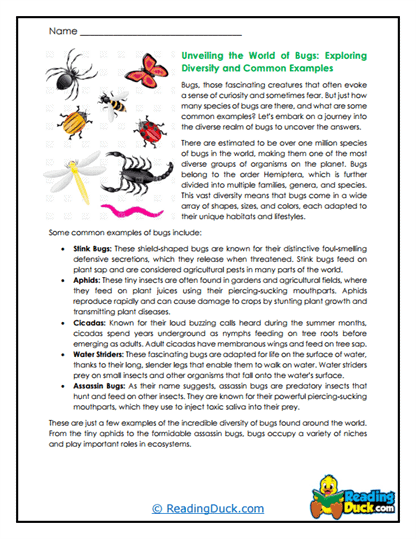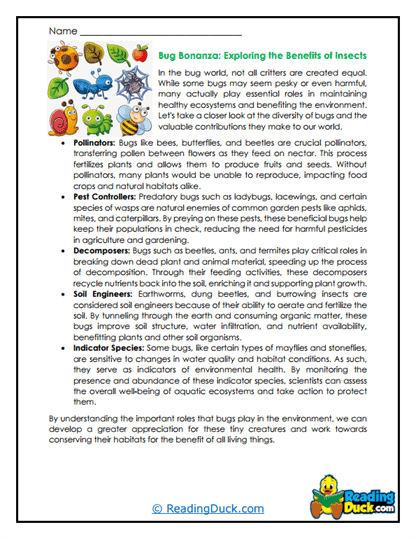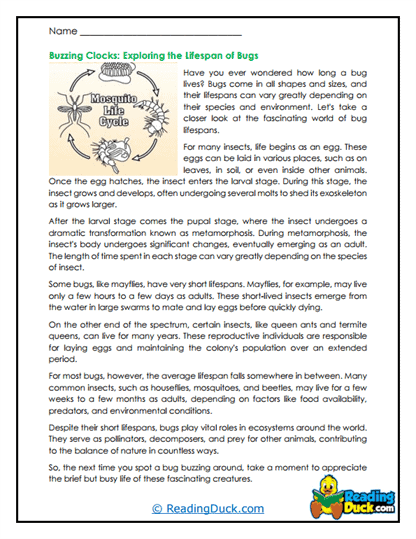Bugs Worksheets
About Our Bugs Worksheets
Our collection of Bugs worksheets offers an engaging and educational exploration into the fascinating world of bugs, making it an essential resource under the broader categories of Science: Biology and Animals. Bugs, including insects and other small arthropods, play crucial roles in ecosystems, from pollination to decomposition. These worksheets are designed to help students understand the diversity, biology, and ecological importance of bugs through engaging reading passages, thought-provoking questions, and opportunities for personal reflection.
This collection is a subtopic within Biology and Animals and contains several worksheet sets. Each worksheet set includes:
- Multiple Choice Questions: These questions assess students' comprehension of the reading passage, ensuring they understand the key concepts and details.
- Short Answer Questions: This section prompts students to write their responses, encouraging them to express their understanding in their own words. This approach helps solidify their knowledge and improve their ability to communicate scientific information effectively.
- Open-Ended Questions: These questions invite students to share their personal thoughts, opinions, and reflections on the material, fostering critical thinking and allowing them to connect more deeply with the content.
Each worksheet is accompanied by a detailed answer key, making it easy for educators and parents to review students' work. The worksheets are provided in PDF format, ensuring they can be easily viewed electronically, downloaded, and printed.
Unveiling the World of Bugs: An Introduction to Insects and Other Arthropods
When introducing students to the topic of bugs, it’s essential to emphasize the incredible diversity and adaptability of these small creatures. Bugs, which include insects, spiders, and other arthropods, are the most numerous and diverse group of animals on Earth. They inhabit nearly every environment, from the deepest oceans to the highest mountains, and play vital roles in maintaining ecological balance. Understanding bugs helps students appreciate the complexity of ecosystems and the interconnectedness of life.
To help students gain a comprehensive understanding of bugs, we can explore the topic through the following key areas:
Types of Bugs: The world of bugs is incredibly diverse, with each group exhibiting unique characteristics and behaviors:
- Insects: Insects are the largest group of bugs and include species such as beetles, butterflies, ants, and bees. Insects have three main body parts (head, thorax, and abdomen), six legs, and often wings. Their life cycles vary, with some undergoing complete metamorphosis (egg, larva, pupa, adult) and others having simpler developmental stages.
- Arachnids: This group includes spiders, scorpions, ticks, and mites. Arachnids have two main body segments (cephalothorax and abdomen) and eight legs. Spiders, for example, are well known for their silk-spinning abilities, which they use to create webs for catching prey or as shelters.
- Myriapods: Myriapods include centipedes and millipedes, creatures with long, segmented bodies and many legs. Centipedes are predators with one pair of legs per body segment, while millipedes are detritivores, feeding on decaying plant material, with two pairs of legs per segment.
- Crustaceans: While commonly associated with marine environments, some crustaceans, like pill bugs (also known as roly-polies), live on land. Crustaceans typically have hard exoskeletons and multiple pairs of legs.
Anatomy and Adaptations: Bugs have evolved a variety of physical adaptations that enable them to thrive in diverse environments:
- Exoskeletons: Bugs are protected by exoskeletons, hard outer shells made of chitin. This exoskeleton provides structural support, protection from predators, and prevents dehydration.
- Sensory Organs: Bugs have highly developed sensory organs, including compound eyes that provide a wide field of vision and antennae that detect chemical signals, vibrations, and environmental changes.
- Wings and Flight: Many insects, such as butterflies, bees, and dragonflies, have wings that allow them to fly. Flight enables these bugs to escape predators, find food, and migrate to new habitats.
- Camouflage and Mimicry: Bugs often use camouflage to blend into their surroundings, making it difficult for predators to spot them. Some bugs, like certain butterflies and moths, use mimicry to resemble other, more dangerous animals, deterring potential threats.
Ecological Roles of Bugs: Bugs play essential roles in ecosystems, contributing to the health and sustainability of their environments:
- Pollinators: Insects like bees, butterflies, and beetles are crucial pollinators. As they move from flower to flower collecting nectar, they transfer pollen, facilitating the reproduction of plants. Pollination is vital for the production of fruits, vegetables, and seeds.
- Decomposers: Bugs such as ants, termites, and beetles break down dead plants and animals, returning essential nutrients to the soil. This decomposition process is critical for nutrient cycling and soil health.
- Predators and Prey: Bugs occupy various positions in the food web. Predatory bugs, like ladybugs and spiders, help control pest populations, while other bugs serve as a food source for birds, reptiles, amphibians, and mammals.
Life Cycles and Behavior: The life cycles and behaviors of bugs are as diverse as the species themselves:
- Metamorphosis: Many insects undergo metamorphosis, a process that involves significant changes in form from one stage to the next. For example, a caterpillar transforms into a butterfly through a pupal stage, while a beetle larva becomes an adult beetle after undergoing a similar process.
- Social Structures: Some bugs, like ants, bees, and termites, live in complex social structures. In these colonies, individuals perform specific roles, such as workers, soldiers, or queens, ensuring the survival and efficiency of the group.
- Communication: Bugs communicate in various ways, including chemical signals (pheromones), sounds (such as the chirping of crickets), and visual cues (like the flashing of fireflies). These communication methods help bugs find mates, defend territory, and coordinate activities.
Conservation and Challenges: Despite their abundance, many bug species face challenges that threaten their populations:
- Habitat Loss: Urbanization, deforestation, and agricultural expansion reduce the natural habitats of many bugs, leading to population declines. Pollinators like bees are particularly vulnerable to habitat loss.
- Pesticides and Pollution: The widespread use of pesticides and other chemicals in agriculture can harm bugs, disrupting ecosystems and reducing biodiversity. Insects that are crucial for pollination and pest control are especially at risk.
- Climate Change: Changes in temperature and weather patterns can affect the life cycles, behavior, and distribution of bugs. For example, warmer temperatures may cause some species to emerge earlier in the year, disrupting their interactions with other species and ecosystems.
By exploring these aspects of bugs, students can develop a well-rounded understanding of these small but vital creatures. These worksheets will guide them through the biology, behavior, and ecological importance of bugs, sparking curiosity and encouraging them to think critically about the role bugs play in the natural world.
Where to Use These Worksheets
Integrating our Bugs worksheets into a school or homeschool curriculum provides numerous opportunities to enhance students' understanding of Biology and the animal kingdom. Here are some practical ideas on how educators and parents can effectively use these worksheets in various educational settings:
- Unit-Based Learning: These worksheets can be used as part of a broader unit on Biology or Life Sciences. After introducing students to basic biological concepts such as ecosystems, adaptation, and classification, the topic of bugs can be explored in greater depth using these worksheets. The worksheets can serve as the foundation for discussions, experiments, and further research on bugs and their ecological roles.
- Classroom Discussions and Group Activities: Encourage students to work in pairs or small groups to discuss the reading passages and answer the questions together. This collaborative approach helps students articulate their thoughts, listen to different perspectives, and deepen their understanding of the material. The open-ended questions, in particular, are excellent for sparking class discussions, where students can share their ideas and engage in debates about the importance of bugs in biodiversity and conservation.
- Research Projects and Presentations: After completing the worksheets, students can be assigned to research and present on specific bugs or topics related to bugs, such as the life cycle of a butterfly, the adaptations of predatory insects, or the impact of human activities on insect populations. They can also explore topics like the role of bees in agriculture or the development of natural pest control methods. These projects can culminate in presentations, reports, or creative displays, allowing students to showcase their knowledge and enthusiasm for the subject.
- Multimedia Integration: Pair the worksheets with multimedia resources to create a more immersive learning experience. For example, students can watch documentaries or educational videos on insect behavior, pollination, or conservation efforts before completing the worksheets. This combination of visual and textual learning can cater to different learning styles and reinforce the concepts covered in the worksheets.
- Homework Assignments: The worksheets are ideal for homework assignments, giving students the opportunity to engage with the material independently. The reading passages and questions are designed to be both challenging and accessible, making them perfect for self-directed study. The answer key allows for easy review, helping students to check their understanding and correct any misconceptions.
By incorporating these Bugs worksheets into the curriculum, teachers and parents can provide students with a comprehensive and engaging learning experience. These worksheets are designed to help students explore the biology, behavior, and ecological importance of bugs, develop critical thinking skills, and foster a lifelong curiosity about the natural world. Whether used in the classroom or at home, these resources will inspire students to appreciate the incredible diversity of bugs and understand the essential roles they play in ecosystems around the world.


